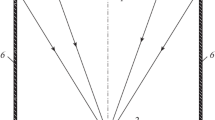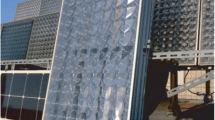Abstract
Photovoltaic (PV) concentrators use lenses or mirrors to concentrate sunlight onto PV cells. This allows for a reduction in the cell area and then significantly reduces in the cost of electricity generated by replacing expensive PV converter area with less expensive optical material. In this paper, an experimental PV low-concentration systems and two photovoltaic concentrators systems were built, the first system consists of a lens which will concentrate the light on a photovoltaic cell; various characteristics of the solar cell practically obtained for various enlightened surfaces Si correspond to the various rates of concentration X. The second experiment was carried out with commercially available PV module, based on reflector mirrors; the incident radiation is concentrated on a PV panel by means of a set of flat mirrors. A concentration X depends on two variables: the slope angle α and the reflectors length C. A comparative electrical and thermal study of PVG and the CPV is presented (with and without concentration).




















Similar content being viewed by others
Abbreviations
- Pac:
-
Packing factor
- PVG:
-
Photovoltaic generator
- STC:
-
Standard test conditions
- CPV:
-
Concentrator system
- A :
-
Length of the PV panel
- cρ :
-
Specific heat (J/Kg K)
- C :
-
Reflectors length
- E g :
-
Semiconductor band gap energy, 1.12 (eV)
- E :
-
Solar irradiance (W/m2)
- FF:
-
Fill factor
- h :
-
Heat transfer coefficient (W/m2 K)
- I :
-
Current (A)
- Is:
-
Saturation current
- Iscref :
-
Short-circuit current reference
- k :
-
Boltzmann’s constant, 1.3807 × 10−23(J/K)
- \( \dot{m} \) :
-
Mass flow rate (Kg/s)
- n :
-
Ideality factor of the diode/number
- P max :
-
Maximum power (W)
- q :
-
Electronic charge, 1.6 × 10−19 (C)
- Q :
-
Heat transfer energy (W)
- Q ele :
-
Electrical energy(W)
- Q th :
-
Thermal energy (W)
- R :
-
Resistance (Ω)
- S :
-
Surface area (m2)
- T :
-
Temperature (°C)
- T R :
-
Reflection factor of the mirror
- t :
-
Time (s)
- V :
-
Voltage (V)
- V oc :
-
Open-circuit voltage (V)
- \( V_{\text{oc}}^{{\prime }} \) :
-
Open-circuit voltage with concentration (V)
- X :
-
Concentration
- η :
-
Efficiency
- τ :
-
Transmissivity
- α :
-
Absorptivity/slop angle
- ρ :
-
Density (kg m−3)
- δ :
-
Thickness (m)
- amb:
-
Ambient
- cond:
-
Conduction
- d :
-
Diode
- ele:
-
Electrical
- G :
-
Generator
- g :
-
Glass, glazing, gap
- p:
-
Parallels
- Ph:
-
Photo-generated
- pv:
-
Photovoltaic module
- s:
-
Series
- sc:
-
Short circuit
- sh:
-
Shunt
- ted:
-
Tedlar
References
Panwar NL, Kaushik SC, Kothari S (2011) Role of renewable energy sources in environmental protection: a review. Renew Sustain Energy Rev 15:1513–1524
Luna-Rubio R, Trejo-Perea M, Vargas-Vazquez D, Rıos-Moreno GJ (2012) Optimal sizing of renewable hybrids energy systems: a review of methodologies. Sol Energy 86:1077–1088
Villalva MG, Gazoli JR, Ruppert E (2009) Comprehensive approach to modeling and simulation of photovoltaic array. IEEE Trans Power Electron 24:1198–1208
Lund H (2014) A Smart energy systems approach to the choice and modeling of 100% renewable solutions, book, renewable energy systems, 2nd edn. Elsevier, Amsterdam
Trieb F, Langnib O, Klailb H (1997) Solar electricity generation—A comparative view of technologies, costs and environmental impact. Sol Energy 59:89–99
Quaschning V (2004) Technical and economical system comparison of photovoltaic and concentrating solar thermal power systems depending on annual global irradiation. Sol Energy 77:171–178
Pitz-Paal R, et al (2005) Development steps for concentrating solar power technologies with maximum impact on cost reduction. In: International solar energy conference (ISEC 2005), Orlando, USA, August 6–12, 2005
Sangani CS, Solanki CS (2007) Experimental evaluation of V-trough (2 suns) PV concentrator system using commercial PV modules. Sol Energy Mater Sol Cell 91:453–459
Miller DC, Kurtz SR (2011) Durability of Fresnel lenses: a review specific to the concentrating photovoltaic application. Sol Energy Mater Sol Cell 95:2037–2068
Ikegami T et al (2001) Estimation of equivalent circuit parameters of PV module and its application to optimal operation of PV system. Sol Energy Mater Sol C 67:389–395
Merten J, Asensi JM, Voz C, Shah AV, Platz R, Andreu J (1998) Improved equivalent circuit and analytical model for amorphous silicon solar cells and modules. IEEE Trans Electron Dev 45:423–429
Esram T, Chapman PL (2007) Comparison of photovoltaic array maximum power point tracking techniques. IEEE Trans Eng Convers 22:439–449
Femia N, Granozio D, Petrone G, Spagnuolo G, Vitelli M (2006) Optimized one-cycle control in photovoltaic grid connected applications. IEEE Trans Aerosp Electron Syst 42:954–972
Geoffrey RW, Sernia PC (2004) Cascaded DC–DC converter connection of photovoltaic modules. IEEE Trans Power Electron 19:1130–1139
Leutz R, Suzuki A (2001) Nonimaging Fresnel lenses: design and performance of solar concentrators. Springer, Berlin
Khamooshi M, Salati H, Egelioglu F, Hooshyar Faghiri A, Tarabishi J, Babadi S (2014) A review of solar photovoltaic concentrators. Int J Photoenergy 2014:17–34
Andreev V, Rumyantsev VD, Grilikhes VA (1997) Photovoltaic conversion of concentrated sunlight. Wiley, Chichester
Stassinopoulos E, Raymond J (1988) The space radiation environment for electronics. Proc IEEE 76:1423–1442
Markvart T, Castaner L (2003) Practical handbook of photovoltaics: fundamentals and applications. Elsevier, Amsterdam
Gallagher SJ, Norton B, Eames PC (2007) Quantum dot solar concentrators: electrical conversion efficiencies and comparative concentrating factors of fabricated devices. Sol Energy 81:813–821
Reis F, et al (2009) Power generation and energy yield using doublesun photovoltaic solar concentration. In: 24th EU PVSEC, Hamburg, Germany, September 2009, pp 803–806
Rejeb O et al (2015) Parameters effect analysis of a photovoltaic thermal collector: case study for climatic conditions of Monastir, Tunisia. Energy Convers Manag 29:409–419
Pérez-Higueras P, Muñoz E, Almonacid G, Vidal PG (2011) High concentrator photo voltaics efficiencies: present status and forecast. Renew Sustain Energy Rev 15:1810–1815
Hollands KGT (1971) Concentrator for thin-film solar cells. Sol Energy 13:149–163
Fraidenraich N, Almeida GJ (1991) Optical properties of V-trough concentrators. Sol Energy 47:147–155
Tabor H (1958) Stationary mirror systems for solar collectors. Sol Energy 2:27–33
Rabl A (1976) Comparison of solar concentrators. Sol Energy 18:93–111
Mroczka J, Plachta K (2014) Modelling and simulation of Λ-ridge concentrator system using commercial PV modules. In: International conference on renewable energies and power quality (ICREPQ), Cordoba, Spain, 8–10 April, 2014
Larionov VR, Malevskii DA, Pokrovskii PV, Rumyantsev VD (2015) Measuring complex for studying cascade solar photovoltaic cells and concentrator modules on their basis. Tech Phys 60:891–896
Author information
Authors and Affiliations
Corresponding author
Rights and permissions
About this article
Cite this article
Boumaaraf, H., Talha, A., Saidi, N. et al. Experimental study of low-concentrator photovoltaic systems: electrical and thermal. Electr Eng 100, 2569–2578 (2018). https://doi.org/10.1007/s00202-018-0722-8
Received:
Accepted:
Published:
Issue Date:
DOI: https://doi.org/10.1007/s00202-018-0722-8




